The Breakdown
Pros
Cons
Can HJC Improve the IS Formula?
The HJC IS-17 is a sort of mashup between the HJC FG-17 (review) and the HJC CL-17 (review).
Both of those helmets were reviewed recently on webBikeWorld and many of you asked for an IS-17 review, so here you go.
In the U.S.A., the IS-17 trades the Snell certification for an internal sun visor, which is something to think about. The IS-17 gets a 5 star rating in the UK SHARP testing programme, however. The IS-17 helmet shell is “polycarbonate composite”, while the FG-17’s shell is listed as “fiberglass composite”, according to HJC.
The IS-17 has a slightly different fit than the CL-17 and FG-17. Also, the ventilation in the IS-17 isn’t as good as the other two helmets. The vent passages in our IS-17 are blocked in the EPS liner and on top of that (literally), the fabric helmet liner covers the vent holes and that pretty much prevents what little air flows through from reaching the rider.
So we’re not quite as impressed with the IS-17 as we were with the other two HJC helmets.
Although the IS-17 has a nice, comfortable fit, big, long and thick chin strap cushions and that sun visor provides outstanding coverage.
In the end, I’ll take the potentially added protection of the Snell M2010 rating over the sun visor.
That’s because studies have shown nearly 23% of all helmet impacts during a crash are concentrated in the forehead region of the helmet, which may be affected by the void that holds the sun visor inside the helmet.
See Also: Helmet Buyers Guide, Helmet Review Home and all HJC Helmet Reviews.
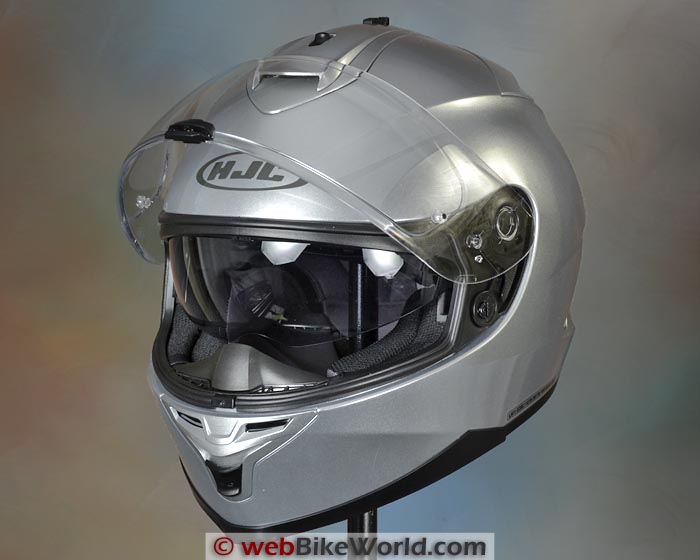
Shopping Now? We Recommend
webBikeWorld has worked closely with RevZilla over the years to provide our testers with products to review. In addition to being a great site to shop from, they’re also a great partner. Both Amazon and Revzilla have a big selection of helmets from the great helmet manufacturers.
RevZilla
Free shipping on orders over $40
30-day no-nonsense return policy
Excellent selection of all major brands
Awesome pricing
Paint, Graphics and Overall Quality
The IS-17 is one of the most popular HJC street helmets and it’s available in solids (black, white, silver, anthracite) and a couple of different graphics.
They include the “Intake” pattern in silver, red, blue, purple and high-viz yellow and the “Genesis” graphic in black and orange.
The plain ol’ silver IS-17 shown here has a nice finish, typically HJC.
No one will be comparing this helmet to a Schuberth, Arai or Shoei, but at around $162.00, does it matter? The paint and finish is good enough and better than many similarly-priced or cheaper helmets I’ve seen.
All of the parts fit and move with good precision, so you won’t feel like you’re getting cheated. As a matter of fact — and also in typical HJC fashion — you’ll feel like you’re getting good value for your hard-earned bucks, pounds, Euros, shekels or Bitcoin.
I do have a couple of gripes, however: the chin curtain is an option, like it was on the CL-17 and CL-16. It should be standard (so raise the price a coupla bucks, eh?) and the Pinlock insert is also an option, which I can understand.
My biggest quality gripe, however, is with the clear face shield. The quality of the plastic molding is off on this example, with some waviness and mold clouds that I noticed right away.
I’m kind of surprised at this because the last couple of HJC helmets we reviewed together didn’t have this problem.
Also, while I’m at it, the vent channels from the top vent down through the EPS aren’t lined up; I’d guesstimate that about 85% of the holes are blocked, which means much less air flowing through the top vent.
A design issue also with the fabric liner along the top of the helmet, which covers the top vent holes anyway, limiting the air flow even further.
The result is very poor air flow through the top of the IS-17 and it’s a shame, because I think the potential is there for even better ventilation than the CL-16 and CL-17.
HJC needs to modify the way the EPS liner is installed in the helmet and also redesign the headliner to make sure there’s a clear shot for the air to flow into the top of the helmet.
Score: I’ll give the HJC IS-17 an “Excellent” rating for overall quality, noting the couple of issues above. See the Summary Table at the bottom of the page for a description of our rating system.
HJC IS-17 Helmet Fit, Internal Shape and Liner
The internal shape of the IS-17 feels slightly different from the FG-17, which itself is a bit different from the HJC CL-16 (review) and CL17.
This IS-17 in size XL fits more like a size L and the internal shape feels “Neutral” to “Slightly Round”, much like the other current HJC helmets. I’ll call it “Neutral” overall.
I think the incorporation of the sun visor in its chamber at the forehead changed the internal shape slightly; it feels a tiny bit less roomy than the CL-17 and the size XL CL-17 feels like an XL, where the IS-17 fits slightly snug.
That’s actually OK though, as long as you know about it, and the IS-17 is comfortable for me otherwise. I’d compare the comfort level as identical to the CL-17, with a nicely padded interior and comfy HJC-standard fabric.
Rick has a “large-and-a-half” sized “Round” shaped head at 60.5 cm and he said the IS-17 fits him perfectly, even with his Randolph Engineering Aviator straight-temple sunglasses (review).
The cheek pads and liner are removable and washable and optional cheek pads are available in XS (40 mm thick) to XXL (25 mm thick) sizes for a bespoke fit. Note that cheek pads thicknesses are counterintuitive — smaller-sized cheek pads are thicker.
For example, if you want to make an XL helmet fit tighter, you order cheek pads from a smaller helmet because they’re thicker. Doesn’t really make sense, but that’s the way it is for all helmet brands I’m aware of…
While you’re at it, be sure to order the optional 4-buck chin curtain — you’ll need it.

More information on helmet fit can be found in the webBikeWorld Motorcycle Helmet FAQ page, along with the chart that lists the helmet weights of webBikeWorld reviewed helmets and also by shape on the webBikeWorld Motorcycle Helmet Shapes page.
Score: We’ll give the HJC IS-17 an “Outstanding” rating for shape, comfort and thick padding.
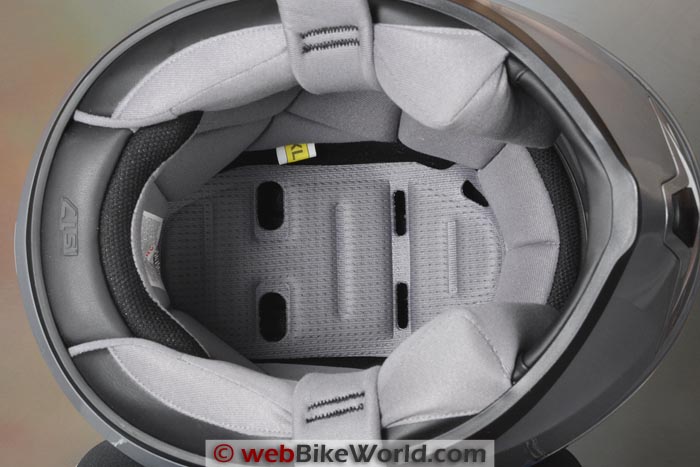
HJC IS-17 Face Shield, Eye Port and Outward Visibility
The face shield and base plate used in the IS-17 is the HJ-20M, used also in the FG-17 (our FG-17 is labeled as an HJ-10M; not sure what the difference is).
Like the FG-17, it looks identical to the HJ-20 used in the RPHA-10, but again, we’re not sure if there’s a difference.
This means that the IS-17 face shield operation is identical to the FG-17, with the center locking lift tab first seen on the HJC RPS-10 (review). It works OK on this helmet; I must be getting used to it.
It also allows the IS-17 face shield to open for a small first defogging or city position, which is a plus.
As I mentioned earlier in the QC section, the face shield on this IS-17 has some uncharacteristic waviness and what I might call “blotchiness” that bother me a little and will probably drive some owners up the wall.
We’ve had emails about this occasional problem with helmet face shields from some webBikeWorld readers; apparently some people are pretty sensitive to it.
The eye port visibility seems about average to slightly better than average and I’m guessing the incorporation of the sun visor means they couldn’t expand the eye port any more than it is. It’s fine though.
Once it’s locked shut, the face shield seals tightly against the full-surround eye port gasket, just like on the FG-17.
Water runs along the top of the gasket and is then shunted along the sides, where it quickly drains down through the rotating mechanism (base plate) and away from the rider.
The HJ-20M base plate on the FG-17 feels good, although not quite as precise as the FG-17 (probably just a manufacturing tolerance).
Like other HJC helmets, the “RapidFire” system makes the face shield very easy to remove and replace, as illustrated in the video below. Optional mirrored and tinted face shields are available as accessories.
The face shield has a first small position for city use and/or defogging and it raises through five detents. It’s also Pinlock ready and a Pinlock anti-fog insert (review) is optional (it’s included with the FG-17).

Score: The HJC IS-17 face shield gets an “Outstanding”, while outward visibility rates a “Very Good”.
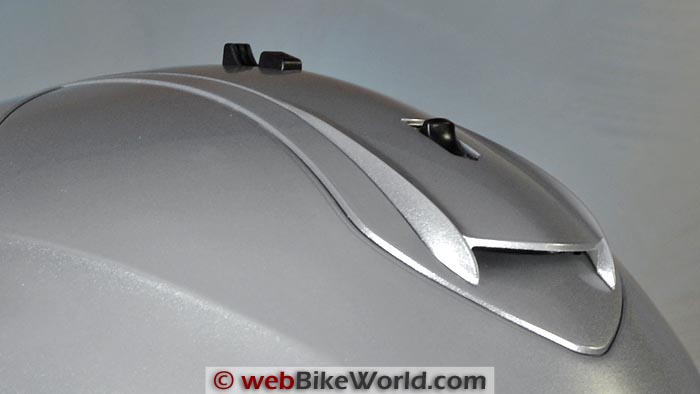
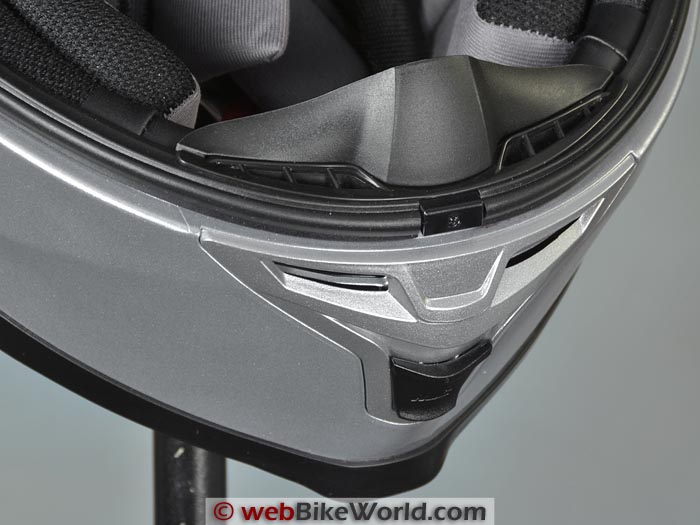
HJC IS-17 Ventilation and Air Flow
Here’s where we run into problems. The ventilation in the IS-17 just doesn’t seem to perform as well as the CL-17, CL-16 or the FG-17 (although the FG-17 was a bit of a disappointment also).
The top vent on the IS-17 looks like it should or could scoop in a good quantity of air, but in our helmet anyway, the holes through the EPS lining aren’t even close to being lined up correctly with the vent holes for the top vent.
The holes through the EPS liner are blocked, which apparently severely limits the air coming into the helmet.
Secondly, the fabric liner design is such that it blocks the vent holes coming into the helmet anyway, so even if a lot of air came into the helmet, chances are the rider wouldn’t feel it because the liner covers the holes.
It’s the same in the rear for the exhaust vents, so something about the EPS liner in our helmet just isn’t right. If you’re buying an IS-17, be sure to take a look inside first.
Both of these issues are simple fixes and it’s surprising that HJC hasn’t caught this.
The chin vent directs air up through the top of the chin bar and this works well. The IS-17 does not come with the chin curtain; it’s a $4.00-$5.00 option and I’d suggest you order one with the helmet.

Score: I’ll rate the upper ventilation system of the HJC IS-17 as “Poor” and the chin vent as “Excellent” overall.
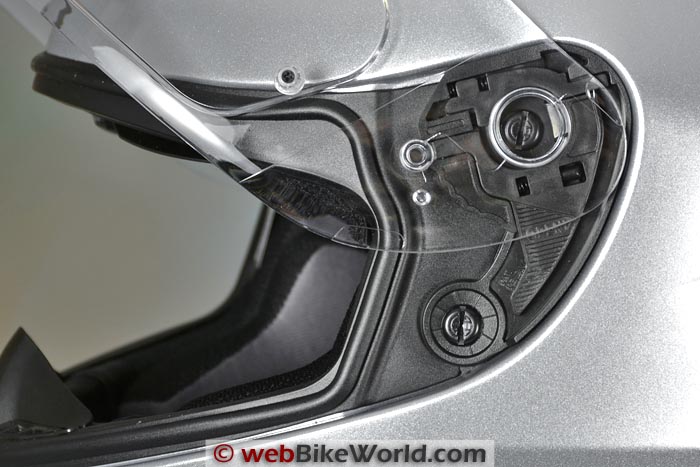
HJC IS-17 Sound Levels
Overall, the IS-17 is a relatively quiet helmet that I’d rate as quieter than average. There’s some general wind noise around the sides, but the slightly tighter fit compared to the FG-17 helps keep noise levels low (assuming, of course, that the helmet matches your head shape and fits correctly).
The IS-17 also seems to work well behind a fairing or windscreen, with relatively low turbulence noise levels.
The noise from the top vent seems low, probably because the top vent holes are blocked.

Note that our helmet evaluations are a combined effort of several riders over time on different types of motorcycles with and without windscreens.
Evaluators wear correctly fitted, high quality ear plugs (even when evaluating motorcycle intercom systems).
Always protect your hearing when riding a motorcycle. See the wBW Earplug Reviews for more information on choosing and wearing earplugs.
Note also that perceived noise levels will vary, depending on the individual.
Noise can be caused by many factors, including helmet fit, the type of motorcycle and windscreen, wind speed and direction and even the rider’s clothing.
For more information on helmet noise, visit the wBW Motorcycle Helmet Noise page.
Score: I’ll give the HJC IS-17 an “Excellent” rating for noise control.
wBW Video: HJC IS-17 Helmet
Helmet Weight
This IS-17 in size XL weighs 1618 grams (3 lbs., 9-1/8 oz.), which is actually not a bad showing for a size XL helmet with an internal sun visor.
For comparison, a size XL Bell Apex weighed 1620 grams; the Shoei X-Eleven in XL weighed 1635 grams and a Bell RS-1 in XL weighed 1644 grams.
The comfortable fit and “Neutral” shape work together to mask the weight and the IS-17 seems to have good aerodynamics.
Note that all of the helmets reviewed on webBikeWorld have been weighed and the weights are available on the wBW Motorcycle Helmet Weights page, along with a chart that lists the helmets by weight and shape on the wBW Motorcycle Helmet Shapes page.
Score: I’ll rate the HJC IS-17 as “Excellent” for its reasonable weight and good balance.
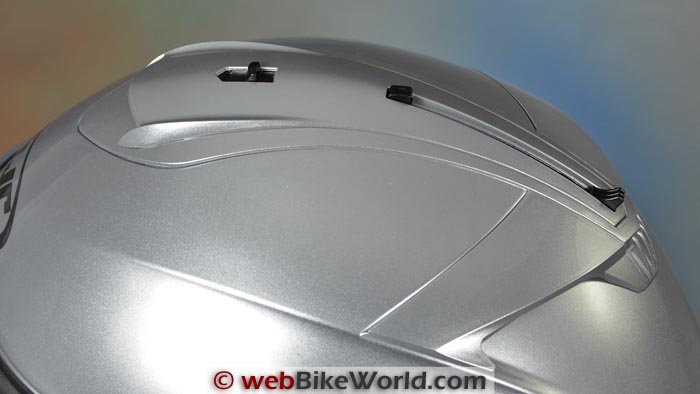
Miscellaneous
The HJC IS-17 has a double-D ring chin strap attachment system with a plastic snap to hold the extra length. The chin strap padding is extra-long and nice and thick, so HJC gets points for that.
The IS-17 meets the DOT standard only in the U.S.A. It is available in sizes ranging from XS to 2XL. Note that the IS-17 received a 5 star rating in UK SHARP helmet testing. We don’t know if HJC submitted the IS-17 for a Snell M2010 test and we also don’t know if the ECE version of the IS-17 is identical to the DOT version.
 Conclusion
Conclusion
The HJC IS-17 gives you a sun visor with about the best coverage in any helmet of its type. Note, however, that the darkness of the tint is limited for legal reasons.
The top vent system in ours is a problem and it’s not clear if this is an issue with other IS-17’s or just certain sizes.
In the end, I still think the CL-16 or CL-17 is the best bargain in the HJC lineup.
Either of those helmets gives you the Snell M2010 certification, although you don’t get the sun visor. We’ve never been big fans of internal sun visors anyway, so safety trumps frills any day of the week.
Overall, the IS-17 just has a few too many issues to make it a favorite and that’s too bad, because just a little more effort on QC at the factory — and perhaps a slight redesign of the liner — could make it a contender.
| wBW Review: HJC IS-17 Helmet | |
|---|---|
| Manufacturer: HJC Helmets | List Price (2014): $179.99-$199.99 |
| Colors: Solids and graphics. | Made In: China |
| Sizes: XS-2XL Shell Sizes: Unknown | Review Date: May 2014 |
|
Rating Scale is subjective: Unacceptable, Poor, Neutral, Very Good, Excellent, Outstanding.
|
|
Where to find the HJC IS-17 Helmet
webBikeWorld has worked closely with RevZilla over the years to provide our testers with products to review. In addition to being a great site to shop from, they’re also a great partner. Both Amazon and Revzilla have a big selection of helmets from the great helmet manufacturers.
RevZilla
Free shipping on orders over $40
30-day no-nonsense return policy
Excellent selection of all major brands
Awesome pricing
Owner Comments and Feedback
See details on submitting comments.
From “H.B.” (May 2016): “I’m just reading your review of HJC IS-17. I do not have this helmet, but I do have FG-17 ST (which apparently is not available in US). This is just FG-17 with internal sun visor.
To quote: “In the end, I’ll take the potentially added protection of the Snell M2010 rating over the sun visor. That’s because studies have shown nearly 23% of all helmet impacts during a crash are concentrated in the forehead region of the helmet, which may be affected by the void that holds the sun visor inside the helmet.”
I think you are going about this wrongly, and I might be supported by the SHARP UK program results.
If you check several helmet results with internal sun visor, you will see that they are mostly not faulted on the front (forehead region), but on the side (where the mechanism for turning the internal visor is situated).
If you check your coveted Shoei GT-Air (review), you’ll see that SHARP gives it RED on the right side, which is worse than any helmet I have ever considered.
I did not study my HJC-FG-17ST (how the turning mechanism looks like), but I did study the AFX-41DS (Which I have with me on board), and after seeing how this “thingie” looks like, I will never wear AFX-41 on my head.
There are some metal fasteners where the sun visor attaches, and there is nothing between one’s head (softest part-temple region) and this metal parts, but 1cm of Styrofoam.
If you check again the Shoei GT-Air, you will see that forehead region gets green there, so it is not the void where sun visor is.”
Editor’s Note: Just to note that Shoei has designed the GT Air specifically to house the sun visor with a larger cavity that sort of protrudes out from the helmet.
They claim in their marking info that the special design is what improves the test results for the GT Air, which is why it scores better in the SHARP test.
As far as I know, no other helmet with an internal sun visor has this special design to help improve impact and crush test results in the forehead.
I’m not a big fan of internal sun visors and never have been, I always find that they add weight and complexity to the helmet, are never dark enough (due to regulations for light transmission) and usually don’t rotate down far enough so that they’re not distracting.
Also, the helmets with sun visors cannot yet pass the Snell M2015 rating.
I wear eyeglasses so I wear the Randolph Engineering Aviator sunglasses (which we have reviewed) when riding, which have straight temples and are designed to fit inside a helmet for military pilots.
One other thing: it’s important to consider all of the different safety standards, including DOT, Snell and other country-specific standards in addition to the SHARP scores. There are pros and cons and controversies with any of them unfortunately.



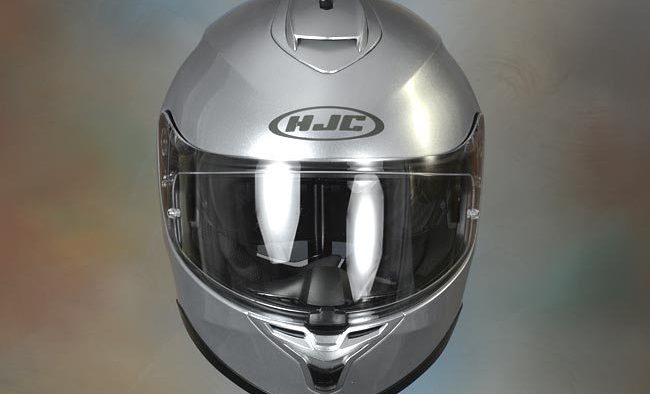

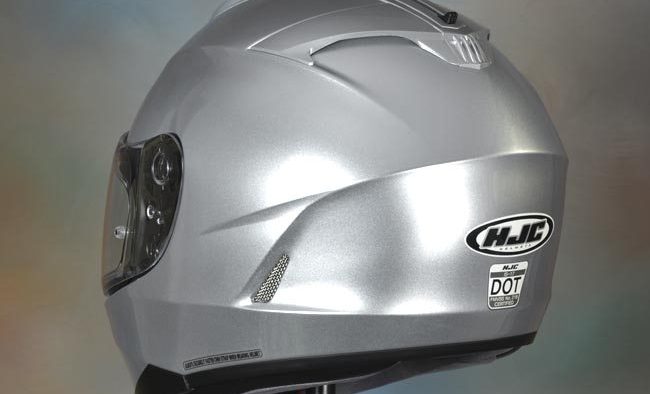
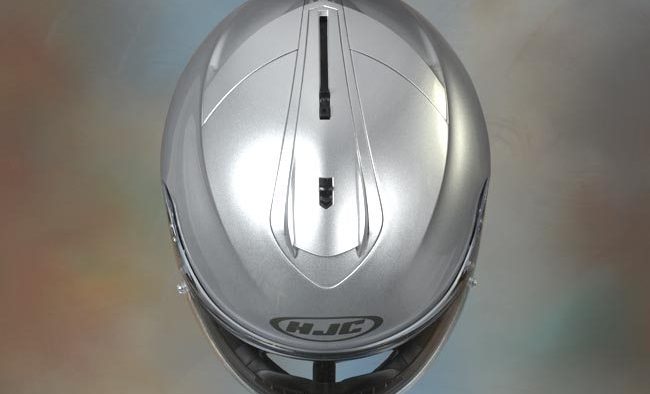
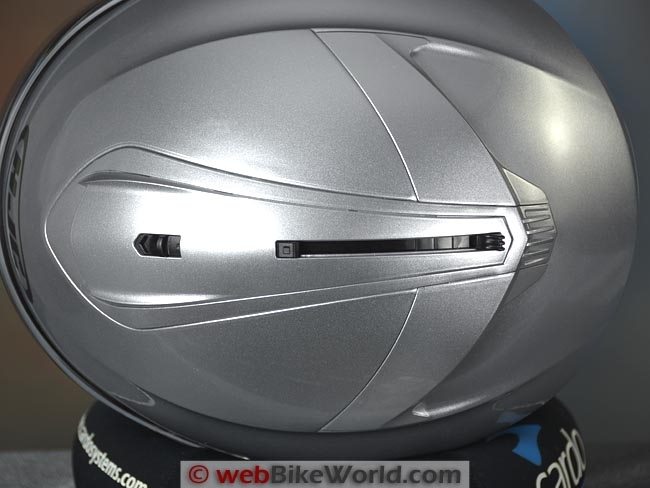

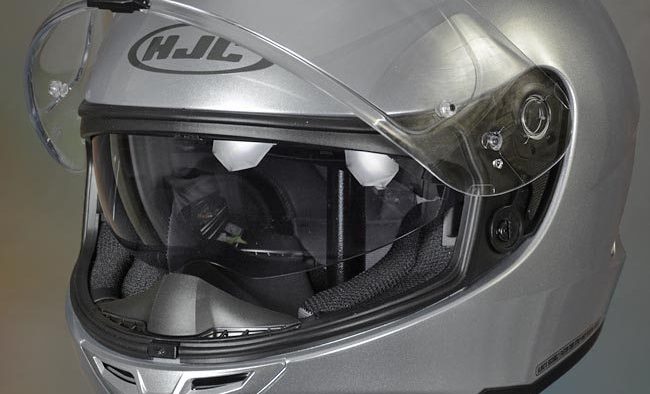






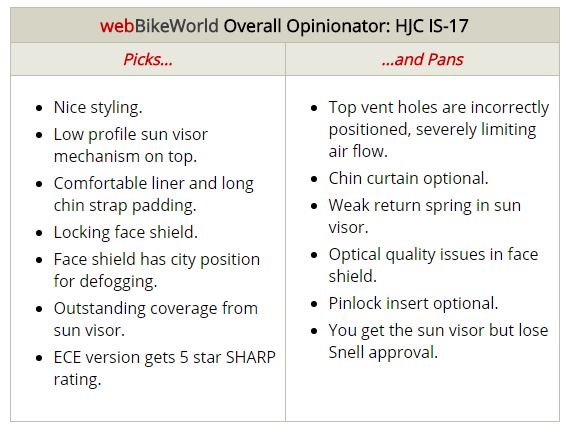 Conclusion
Conclusion
I have the largest IS-17 and it hurts to wear it! There are 2 head ache inducing pressure points on the forehead, the cheeks are so tight I have to bite through the flesh to close my mouth and the ears feel like they are being cut off after 15 minutes.
you can’t use any coms and the wind noise is very loud at speeds above 50 mph and unbearable at 70mph regardless of the bike you are on.